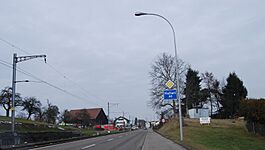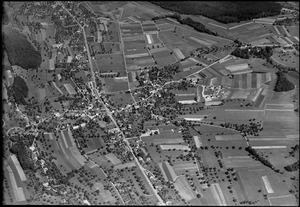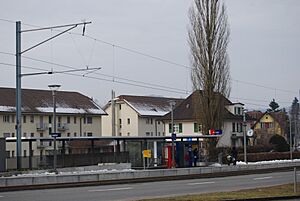Hallwil facts for kids
Quick facts for kids
Hallwil
|
||
|---|---|---|
 |
||
|
||
| Country | Switzerland | |
| Canton | Aargau | |
| District | Lenzburg | |
| Area | ||
| • Total | 2.18 km2 (0.84 sq mi) | |
| Elevation | 475 m (1,558 ft) | |
| Population
(Dec 2020 )
|
||
| • Total | 949 | |
| • Density | 435.3/km2 (1,127/sq mi) | |
| Postal code |
5705
|
|
| Surrounded by | Boniswil, Dürrenäsch, Leutwil, Seengen, Seon | |
Hallwil is a small town, also called a municipality, located in the Lenzburg district in the canton of Aargau in Switzerland. It's a quiet place with a rich history.
The famous Castle of Hallwyl is actually found in the nearby town of Seengen.
Contents
Hallwil's History
Hallwil was first mentioned in old records in the year 1167. Back then, it was called de Allewilare. For a long time, between 1566 and 1950, it was officially known as Niederhallwil.
In 1415, the Habsburg family lost their power in Hallwil when the region was taken over by Bern. This meant they no longer controlled the important legal decisions, known as "high justice." Later, the local Lords of Rinach and Hallwyl held the "low justice" rights, which covered smaller legal matters. These rights eventually also went to Bern.
The church in Seengen used to collect a tax called tithes, which was a portion of crops or income. These tithes later belonged to the Lords of Hallwyl, who then gave them to the church. In 1528, Bern changed its official religion to Protestantism, and Hallwil became part of the Seengen church area.
How Hallwil Grew: From Farms to Factories
For many years, farming was the main way people made a living in Hallwil. But in the 1700s, new industries started to grow. People began making things like straw braids, silk ribbons, and linen fabrics.
Later, from 1864 to 1971, making cigars became very important for the town's economy. In 1883, Hallwil got its own train station, connecting it to the larger Swiss Federal Railways network. This helped the town grow and transport goods.
By the end of the 1900s, Hallwil had many small businesses, especially in services and making equipment.
Hallwil's Geography and Landscape
Hallwil is located in the Lenzburg district, on the left side of the beautiful Seetal valley. It's about 1.5 kilometers (about 1 mile) northwest of the famous Hallwyl Castle. The town itself is a linear village, meaning its buildings are mostly spread out along a road.
Land Use in Hallwil
As of 2009, Hallwil covers an area of about 2.19 square kilometers (0.85 square miles). Here's how the land is used:
- Most of the land, about 69.4%, is used for farming.
- About 12.8% of the area is covered by forests.
- The remaining 19.6% is where buildings and roads are located.
In the built-up areas, about 2.7% are industrial buildings, 11.0% are homes, and 5.5% are roads and transportation areas. The forests are mostly dense, with a small part used for orchards or small groups of trees. For farming, 47.5% is used for growing crops, 18.3% for pastures, and 3.7% for orchards or vineyards.
Hallwil's Coat of Arms
The coat of arms for Hallwil shows a green palm tree with golden fruits. It stands on a green hill, all on a red background. This design is called Gules a Palm tree Vert fructed Or issuant from Coupeaux of the second.
Hallwil's Population
As of June 2009, Hallwil has a population of 722 people. About 14.1% of the people living here are from other countries. Over the past 10 years (1997–2007), the population has grown slightly.
Languages Spoken
Most people in Hallwil speak German, which is about 89.5% of the population. Albanian is the second most common language (3.5%), followed by Italian (3.2%).
Age Groups
Here's a look at the age groups in Hallwil as of 2008:
- Children (0-9 years old): 8.8%
- Teenagers (10-19 years old): 10.9%
- Young Adults (20-29 years old): 11.5%
- Adults (30-39 years old): 15.5%
- Adults (40-49 years old): 19.5%
- Adults (50-59 years old): 14.7%
- Seniors (60-69 years old): 11.1%
- Seniors (70-79 years old): 4.7%
- Seniors (80-89 years old): 2.8%
- Seniors (90 and older): 0.4%
Homes and Households
In 2000, the average number of people per living room was 0.53. This is similar to the average for the whole canton. About 51% of homes were owned by the people living in them.
In 2000, there were 311 private homes and apartments in Hallwil. The average household had 2.3 people. In 2008, 149 homes were single-family houses, making up 41.4% of all homes. There were only 7 empty apartments, meaning a very low vacancy rate of 1.9%.
Political Choices
In the 2007 federal election, the most popular political party in Hallwil was the SVP, which received 50.6% of the votes. Other popular parties included the FDP (10.8%), the SP (10.3%), and the Green Party (7.4%).
Historical Population Growth
Here's how Hallwil's population has changed over time:
| Historical population | ||
|---|---|---|
| Year | Pop. | ±% |
| 1798 | 396 | — |
| 1850 | 428 | +8.1% |
| 1900 | 387 | −9.6% |
| 1950 | 508 | +31.3% |
| 2000 | 721 | +41.9% |
Hallwil's Festivals and Customs
Hallwil is special because it still celebrates several old midwinter festivals. These traditions were once common in the whole Seetal region, but now they mostly happen only in Hallwil.
- Chlauschlöpfen: This festival involves cracking a whip loudly to "wake up" Saint Nicholas.
- Klausjagen: Originally, this custom was about chasing away wild spirits. Today, it's a parade that follows Saint Nicholas.
- Wienechtschind: On December 24th, seven girls, known as "Christmas children," walk through the town singing at each house.
- Silvestertrösche: On New Year's Eve, a large bonfire is lit on a hill near Hallwil to celebrate Silvester.
- Bärzeli: This custom takes place on Berchtoldstag (January 2nd). Fifteen people dressed in special costumes, called Bärzeli, march through the village streets, bringing good luck to everyone they meet.
Hallwil's Economy
In 2007, Hallwil had a low unemployment rate of 1.75%. This means most people who wanted to work had jobs.
Types of Jobs
As of 2005, jobs in Hallwil were divided into three main types:
- Primary sector: 23 people worked in this sector, which includes farming and other jobs that get raw materials from nature. There were about 9 businesses in this area.
- Secondary sector: 136 people worked in this sector, which involves manufacturing and making things. There were 20 businesses here.
- Tertiary sector: 107 people worked in this sector, which includes services like shops, offices, and healthcare. There were 41 businesses in this area.
Commuting to Work
In 2000, 409 people who lived in Hallwil had jobs. About 75.8% of these residents worked outside of Hallwil. However, 187 people came into Hallwil for work. This means there were 286 jobs available in the municipality.
For getting to work, 9.8% of the working population used public transportation, while 57.9% used a private car.
Religion in Hallwil
According to the 2000 census, 23.4% of Hallwil's population were Roman Catholic, and 54.2% belonged to the Swiss Reformed Church.
Education in Hallwil
Switzerland is known for its good education system. In Hallwil, about 73.7% of adults (between 25 and 64 years old) have completed either high school or gone on to higher education, like university.
Local Schools and Libraries
In the 2008/2009 school year, 45 students attended primary school in Hallwil. The town also has a public and school library called Gemeindebibliotheken und Schulbibliotheken. As of 2008, this library had 3,455 books and other media. It was open for 120 days that year, usually for about 4 hours per week.
See also
 In Spanish: Hallwil para niños
In Spanish: Hallwil para niños









